Wolf's Head (secret society)
Wolf's Head Society is a senior society at Yale University in New Haven, Connecticut. The society is one of the reputed "Big Three" societies at Yale, along with Skull and Bones and Scroll and Key.[1] Active undergraduate membership is elected annually with sixteen Yale University students, typically rising seniors. Honorary members are elected.
 Wolf's Head "New Hall" - architect Bertram Grosvenor Goodhue, designed circa 1924 | |
| Formation | 1883 |
|---|---|
| Type | Secret society local |
| Headquarters | Yale University |
| Location |
|
Region served | United States |
The current delegation spends its year together answerable to an alumni association.[2][3][4] Some past members have gained prominence in athletics, business, the fine and literary arts, higher education, journalism, and politics.
History
Fifteen rising seniors from the Yale Class of 1884, with help from members of the Yale Class of 1883 who were considered publicly possible taps for the older societies, abetted the creation of The Third Society. The society changed its name to Wolf's Head five years later.[5][6][7]
The effort was aided by more than 300 Yale College alumni[8][9] and a few Yale Law School faculty, in part to counter the dominance of the Skull and Bones Society in undergraduate and university affairs.[7][10]
The founding defeated the last attempt by the administration or the student body to abolish secret or senior societies at Yale.[11] The tradition continued of creating and sustaining a society if enough potential rising seniors thought they had been overlooked: Bones was established in 1832 after a dispute over selections for Phi Beta Kappa awards; Scroll and Key Society, the second society at Yale, was established in 1841 after a dispute over elections to Bones.
The Third Society's founding was motivated in part by sentiment among some young men that they deserved insider status. "[A] certain limited number were firmly convinced that there had been an appalling miscarriage of justice in their individual omission from the category of the elect," some founders agreed.[7][12][13]
Antecedents
Before the founding in 1780 at Yale of the Connecticut Alpha chapter of Phi Beta Kappa, the second chapter established after that society's founding in 1776 (which still practices a secret handshake among members),[14] Yale College students established and joined literary societies.[15] By the 1830s, the campus literary societies Linonia, Brothers in Unity, and Calliopean had lost stature. Calliopean folded in 1853, and the others shut down after the American Civil War.[16] Calliopean, Linonia, and Brothers in Unity existed respectively: 1819–1853, 1768–1878, and 1735–1868.[17]
From the mid-1840s until 1883, several societies were started, but each failed to sustain the interest of liberal arts students at Yale College, broadly known as the Academical Department.[18] Star and Dart, Sword and Crown, Tea-Kettle, Spade and Grave, and E.T.L. disbanded.[19]
Phi Beta Kappa was inactive at Yale from 1871 to 1884, coinciding in part with a national reorganization of the society.[20] In the 1820s, Anti-Masonic agitation sweeping across the United States prompted PBK to examine the role of secrecy in its proceedings. Associated with PBK's national reorganization in 1881, secrecy disappeared as a signature among all chapters, quelling rivalry with collegiate fraternities, clubs and societies.[21] Hence, secrecy was soon shelved at the Yale chapter.[22] PBK exists today, without any secrecy, as an academic honor society.
Beginning in the 1850s, the Yale undergraduate student body grew more diverse. The college was becoming an institution of national rather than regional importance. Students who hailed from environs beyond New England or who were not Congregationalist or Presbyterian entered the college in large numbers.[23]
The faculty and administration were dominated by alumni of Bones, numbering four out of five faculty members between 1865 and 1916. Bones alumni were university secretaries from 1869 to 1921. Bones alumni were university treasurers for forty-three of the forty-eight years between 1862 - 1910.[24][25] Five of the first six Yale Corporation elected Alumni Fellows were members of Bones.[26]
Dissatisfaction grew: In 1873, The Iconoclast, a student paper published once, October 13, 1873, advocated for the abolition of the society system. It opined: "Out of every class Skull and Bones takes its men...They have obtained control of Yale. Its business is performed by them. Money paid to the college must pass into their hands, and be subject to their will....It is Yale College against Skull and Bones!! We ask all men, as a question of right, which should be allowed to live?"[27][28] The Yale Daily News first appeared on January 28, 1878. A memoir of the first college daily's birth records its first year strategy to "rag" the societies.[29]
The Class of 1884 agreed to support another revolt against the society system with a vote of no confidence to coincide with its graduation. It had been understood that the society system was beyond reform and might well be abolished.
A spirited defense of the society system appeared in the May 1884 issue of The New Englander, written and published by members of Scroll and Key. Several periodicals reported regularly on the situation.[30]
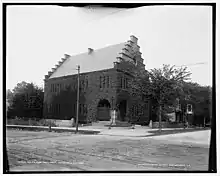
Establishment
The initial delegation, including ten Class Day officers from the Class of 1884 and led by Edwin Albert Merritt, met in secret during their senior year with the aid of members of the Class of 1883 who were "eager to start a society provided the evil features of the old societies would be eliminated. [The graduating and rising seniors] were unanimous on this point." Included among the supporters from the Class of 1883 were members touted as sure selections to Bones or Keys by the publishers of the Horoscope, an undergraduate publication that provided feature material on the most likely taps. The pro-society seniors won the Class Day vote, 67 - 50.[31]
The new society was conceived on or about June 5, 1883. Among undergraduates the fledgling group was known as the "Fox and Grapes" for the Aesopian fable of jealousy.[32]
The two older societies suffered by comparison with Wolf's Head.[33] The New Haven Register reported in 1886: "Wolf's Head is not as far out of the world, in respect to its public doings, as are [Bones and Keys]. There is a sufficient veil of secrecy drawn around its mechanism, however, to class it with the secret societies, and this gives it a stability and respectability in Yale College circles that it might not have otherwise...."[34] The society was managed similarly to finals clubs associated with the Sheffield Scientific School; however, it soon took on almost all aspects of the older societies.[7]
Early stature
The Third Society sat at the apex of a social pyramid bricked by junior societies (sophomore societies were abolished in 1875, freshman societies in 1880),[35] campus organizations, athletic teams, clubs, and fraternities.[36][37]
In 1888, the society changed its name to Wolf's Head Society, consonant with the approval among undergraduates of the society's pin, a stylized wolf's head on an inverted ankh, an Egyptian hieroglyphic known as the Egyptian Cross or "the key of life". The earliest undergraduate members allowed fellow schoolmates to handle the pin, a specific refutation of pin display by the older societies. Eternal life is symbolized rather than death or erudition. A Roman fasces had been considered as a design element for the pin.[7][38]
Point of view
Many pioneering and subsequent members mocked as "poppycock" (from the Dutch for "soft excrement")[39] the seemingly Masonic-inspired rituals and atmosphere associated with Skull and Bones. The sentiment was widespread in the Yale community particularly among undergraduates. In their The Pirates of Penzance prank, Wolf's Head members persuaded the thespian pirate king to display the numbers 322 (part of the emblem of Skull and Bones) below a skull and crossbones at a local theatre.[40] In another example, Yale President A. Whitney Griswold's deprecated the rituals as "bonesy bullshit" and "Dink Stover crap" coloring undergraduate life.[41]
Wolf's Head did maintain many traditional practices, such as the Thursday and Sunday meetings, which were common among its peers. Paul Moore, Jr., long-time Senior Fellow and successor trustee (1964 - 1990) for the Yale Corporation and long-tenured bishop in the Episcopal Church (United States), recalled the night before he first encountered combat in World War II: "I spent the evening on board ship being quizzed by [a friend from Harvard] about what went on in Wolf's Head. He could not believe I would hold back such irrelevant secrets the night before I faced possible death."[42][43]
Original Tomb
The original tomb, or hall, was erected within months of the founding. The older Academical Department societies met originally for decades in rented quarters near campus. Skull and Bones opened its tomb in 1856, more than two decades after its founding.[44] Scroll and Key did likewise; it opened its tomb in 1869 more than two decades after the society's founding.
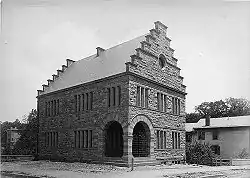
- The former domicile is located at 77 Prospect Street, across the street from the Grove Street Cemetery, was a Richardsonian Romanesque building commissioned for the Phelps Trust Association and designed by the architectural firm McKim, Mead and White. It was completed in 1884. It was purchased by the university in 1924, rented to Chi Psi fraternity (1924–29), Book and Bond (defunct society) (1934–35), and Vernon Hall (now Myth and Sword) (1944–54). It currently houses the Yale Institution for Social and Policy Studies.[45]
A building with narrow windows, the domicile was noted as "the most modern and handsomest" of same purpose structures by The New York Times in 1903. The building was erected in 1884 soon after the founding members secured financing.[7]
Current Tomb
- Bertram Goodhue, architect, designed the "New Hall", ca. 1924; it was built posthumously. Goodhue was a protege of James Renwick Jr., architect of the first St. Anthony Hall chapter house in New York City.[46]
The building has stone wall and wrought iron fencing, and is central to the largest secret society compound on campus. The compound commands the most prominent location on campus beyond Harkness Tower, the very icon of Yale,[47] and the Memorial Quadrangle.
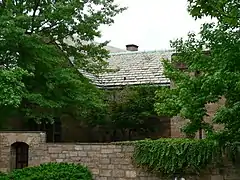
The domicile opened in the mid-1920s and sits fronted by York Street surrounded by the Yale Daily News Briton Hadden Memorial building, and the David Geffen School of Drama at Yale University. The original School of Drama and theatre as well as the Briton Hadden Memorial Building, were gifts to Yale from Edward Harkness.[46] It is near the former homes of the Fence Club (or Psi Upsilon, 224 York Street), DKE (232 York Street) and Zeta Psi (212 York Street).
Membership
The society has been reputed to tap the gregarious "prep school type".[48][49] Past members were associated intimately with the: coeducation of Yale College,[50] establishment of the Yale residential college system and the Harvard house system,[51] founding of the Elizabethan Club,[52] and founding of the Yale Political Union.[53]
This was Yale's last all-male society. Women have been tapped since the spring of 1992.[54]
Edward John Phelps, Envoy to the Court of St. James's, accepted the offer in 1885 to be namesake to the Wolf's Head alumni association.[7] The Phelps Association, as of January 2016, holds in trust nearly seven million dollars, second among Yale societies or clubs.[55]
Yale societies contrast sharply with Harvard finals clubs on membership criteria. Contributions to undergraduate life has been historically among the criteria for membership in Yale societies. Finals clubs overlook that quality among prospective members.[56][57]
Notable members


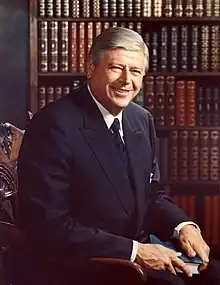

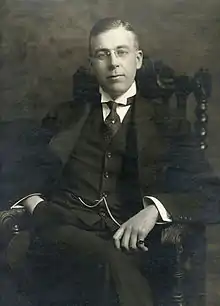
.jpg.webp)

- Malcolm Baldrige, Jr., former U.S. Secretary of Commerce[58]
- Leigh Bardugo (1997), Israeli-American author[59]
- Charles L. Bartlett, Pulitzer Prize winning journalist
- Donald Beer (1957), Competition Rower and Olympic Champion[60]
- Stephen Vincent Benét (1919), Pulitzer Prize–winning American poet, short story writer, and novelist[61]
- Clarence Winthrop Bowen (1883), American author of historical essays[62]
- David Josiah Brewer, Justice of the US Supreme Court[63]
- James Smith Bush (1844), Episcopal priest
- William H.T. Bush (1950), Businessperson
- John Charlesworth (1929), American football player[64]
- Thomas Charlton (1956), competition rower and Olympic medalist[65]
- Sam Chauncey (1957), Yale administrator[66]
- John Proctor Clarke, Justice of the New York Supreme Court[67]
- Alexander Smith Cochran (1896), manufacturer and philanthropist[68]
- Erastus Corning 2nd (1932), New York politician[69]
- Parker Corning (1895), businessman and US Representative[70]
- Mark Dayton (1978), retired Minnesota senator and governor
- Robert Fiske (1952), attorney and law partner[71]
- William Clay Ford (1949), businessman and heir[72]
- Richard Gilder (1954), philanthropist and businessman[73]
- Paul Goldberger (1972), architecture critic[74]
- A. Conger Goodyear (1899), philanthropist and first President of Museum of Modern Art[75]
- A. Whitney Griswold (1929), 16th President of Yale[76]
- Edwin S. Grosvenor (1973), President and Editor-in-Chief of American Heritage
- Ashbel Green Gulliver (1919), dean of Yale Law School[61]
- Charles Harkness (1883), investor and heir[77]
- Edward Harkness (1896), philanthropist and major benefactor to Yale[78]
- William L. Harkness, American businessman
- Robert Maynard Hutchins (1921), collegiate administrator and president of the University of Chicago[79]
- Charles Edward Ives (1898), American modernist composer[80]
- Dick Jauron (1973), American football player[81]
- William Woolsey Johnson, American mathematician[82]
- Rashid Khalidi (1970), Palestinian American historian[74]
- Lewis Lehrman, investment banker and politician[83]
- Christopher Lydon, media personality and commentator[74]
- Douglas MacArthur II (1932), American diplomat[84]
- Wayne MacVeagh, American politician and former United States Attorney General[85]
- William Matthews (1965), poet, winner of the Ruth Lilly Poetry Prize
- Edwin Merritt (1884), New York Politician[86]
- Clark Millikan (1924), American academic[87][88]
- Roger Milliken (1937), American heir, industrialist, and businessman[89]
- Douglas Moore (1915), composer and author[90]
- Paul Moore, American bishop[91]
- Paul Moore, Sr. (1908), American businessman[92]
- Jack Morrison (1967), American ice hockey Olympic athlete [93]
- Thruston Morton (1929), US Senator[94]
- Rogers C. B. Morton, U.S. Representative, United States Secretary of the Interior and United States Secretary of Commerce
- Edward John Phelps, Lawyer and diplomat[95]
- Philip W. Pillsbury (1924), Chair of Pillsbury Company[87][96]
- Ducky Pond (1925), American football and baseball player[97]
- Geoffrey Robinson, British politician and businessperson
- Benno C. Schmidt, Jr., 20th President of Yale[98]
- Kurt Schmoke (1971), American lawyer and politician[99]
- Raymond Seitz, (1963), American Ambassador to the United Kingdom
- Edmund Clarence Stedman, American poet, critic, essayist, banker, and scientist[82]
- Tom Steyer (1979), American business man and liberal political activist[100]
- William Earl Dodge Stokes, Businessman and urban developer[101]
- Sam Wagstaff, American art curator and collector[102]
- Rusty Wailes (1958), American rower[103]
- Clarissa Ward (2002), Emmy award-winning American journalist
- Arthur Williams Wright (1859), American physicist
- Douglas Wick (1976) Academy Award-winning film producer
- Doug Wright (1985), Pulitzer Prize winning American playwright, librettist, and screenwriter[104]
- William Wrigley III (1954), president of the Wm. Wrigley Jr. Company[105]
Notes
- Caro, Robert (1974). The Power Broker: Robert Moses and the Fall of New York. New York: Knopf. ISBN 978-0-394-48076-3. OCLC 834874.
- "Dear Wolf's Head", Blog, Yale Daily News, 02 May 2013
- , article "New book ignites society debate", Britton O'Daly, Yale Daily News, 5 Oct, 2017
- "The Choice is Yours", Blog, Yale Daily News, 24 February 2017
- "Timeline of Selected Events in the History of Yale University". Resources on Yale History. Yale University Library. March 19, 2010. Retrieved 2011-08-01.
- Yale Alumni Publications, Inc. "March 2001 Tercentennial Edition - An Irrepressible Urge to Join". Yale Alumni Magazine. Retrieved 2011-08-01.
- Andrews, John. History of the Founding of Wolf's Head, Lancaster Press, 1934. Phelps Trust Association archives, Sterling Memorial Library, Yale University.
- Bulletin of Yale University, New Haven, 15 October 1932, Obituary Record of Graduates of Yale University Deceased during the Year 1931 - 1932, pg. 32, Henry Blodget, B.A. 1875, and pg. 44, John Proctor Clarke, B.A. 1878
- Obituary Record of Yale University 1924 - 1925, Bulletin of Yale University, New Haven, Twenty-First Series, August 1, 1925, Number Twenty - Two, Abram Heaton Robertson, B.A. 1872, pg. 1316, Gardner Green, B.A. 1873, pg. 1319
- John Williams Andrews (2008-04-01). "History of the founding of Wolf's Head". Open Library. OL 6318007M. Retrieved 2011-08-01.
- Richards, David Alan. Skulls and Keys, Pegasus Books, Ltd. NY, NY, 2017, pp. 284 - 327, "The Solution of Wolf's Head (1883 - 1888)" pp. 284 - 327. ISBN 978-1-68177-517-3
- "Changes in Skull and Bones, Famous Yale Society Doubles Size of its House - Addition a Duplicate of Old Building". The New York Times. September 13, 1903. p. 22.
- Oren, Dan. Joining the Club: A History of Jews and Yale, Second Edition. Yale University Press, New Haven and London, 2000. pp. 332-333. ISBN 0-300-08468-4.
- Nadrina Ebrahimi, Yale Daily News, "Phi Beta Kappa to induct 25 students", 7 December 2016,
- "Welcome | Yale Phi Beta Kappa". Yale.edu. Retrieved 2016-09-04.
- Secrets of the Tomb, pp. 36, 38.
- Havemeyer, Loomis. "Yale's Extracurricular & Social Organizations, 1780 - 1960" (PDF). Yale Library. pp. 5, 8.
- Robbins, Alexandra. Secrets of the Tomb: Skull and Bones, the Ivy League, and the Hidden Paths to Power. Back Bay Books, New York and Boston, pp. 61-62. ISBN 0-316-73561-2.
- Andrews, p. 75.
- Joining the Club. p. 22.
- "Phi Beta Kappa - History". Clubs.psu.edu. Retrieved 2016-09-04.
- "Tombs and Taps, An inside look at Yale's Fraternities, Sororities and Societies". Conspiracyarchive.com. Retrieved 2011-08-01.
- Stephenson, Louise L. Scholarly Means to Evangelical Ends: The New Haven Scholars and the Transformation of Higher Learning in America.The Johns Hopkins University Press, 1986, p. 64; ISBN 0-8018-2695-0.
- Secrets of the Tomb. pp. 48, 50, 127.
- Joining the Club. p. 26.
- Skulls and Keys, p. xix
- Andrews, p. 39.
- Karabel, Jerome. The Chosen: The Hidden History of Admission and Exclusion at Harvard, Yale, and Princeton. Houghton Mifflin Company, Boston and New York, 2005. p. 56. ISBN 978-0-618-57458-2.
- Skulls and Keys, p. 259
- Andrews, pp. 58-61.
- Andrews, p. 70.
- Skulls and Keys, p.293 and p.292
- Skulls and Keys, p. 320
- Secrets of the Tomb, p. 63.
- Andrews, p. 46.
- Caro, Robert (1974). The Power Broker: Robert Moses and the Fall of New York. New York: Knopf. p. 38. ISBN 978-0-394-48076-3. OCLC 834874.
- Kabaservice, Geoffrey. The Guardians: Kingman Brewster, His Circle, and the Rise of the Liberal Establishment. Henry Holt and Company, New York, 2004. p. 45. ISBN 0-8050-6762-0.
- Secrets of the Tomb. p. 68.
- "Poppycock | Definition of Poppycock by Merriam-Webster". Merriam-webster.com. Retrieved 2016-09-04.
- Secrets of the Tomb, pp. 3-4, 67, 84-85.
- The Guardians. p. 155.
- Yale officers: Founding Trustees and their successors,[www.guides.library.yale.edu]
- Moore, Paul. Presences: A Bishop's Life in the City. Farrar, Straus, and Giroux, New York, 1997. pp. 55-56; ISBN 0-374-23711-5.
- Yale Alumni Magazine, May/Jun 2015, "The Origins of the tomb: How Skull and Bones found a home", by David Richards
- "Institution for Social and Policy Studies". Yale.edu. Retrieved 2016-09-04.
- Kelley, Brooks Mather.Yale: A History, Yale University Press, New Haven and London. p. 374. ISBN 0-300-01636-0.
- "Yale University Guild of Carillonneurs - Harkness Carillon and Guild Information". Yale.edu. Archived from the original on 2000-11-09. Retrieved 2016-09-04.
- "Inside Eli, or How to Get On at Yale". Yale56.org. 1955–56. Retrieved 2011-08-01.
- Secrets of the Tomb. p. 69.
- "The Guardians". p. 64
- Judith Ann Schiff; Yale Alumni Publications, Inc. (May–June 2008). "How the Colleges Were Born". Yale Alumni Magazine: Old Yale. Archived from the original on 2008-05-22. Retrieved 2013-10-09.
- "Real Shakespeare Treasures For Yale" (PDF). The New York Times, November 20, 1911.
- The Guardians. p. 51.
- "Yale Wolf's Head Admits Women". Deseret News, December 19, 1991.
- Business Insider, Jan. 5, 2016, 5:01 ET, by line Abby Jackson
- "Eleven Final Clubs: From Pig to Bat | News | the Harvard Crimson".
- "YALE's FINEST HOURS | News | the Harvard Crimson".
- "The Skulls and Bones Exposed". Scribd.com. 2009-02-18. Retrieved 2011-08-01.
- "Leigh Bardugo On 'Ninth House'". NPR.org. Retrieved 2019-12-04.
- Yale Banner and Pot Pourri Yearbook, New Haven, CT, Class of 1957, pg. 47
- "Memorabilia Yalensis". The Yale Literary Magazine. 84 (6): 269. June 1919. Retrieved 2011-08-01.
- Skulls and Keys, p. 302
- Skull and Keys, pg. 319
- Yale University Banner and Pot Pourri Yearbook, New Haven, CT - Class of 1929, pg.109
- Yale Pot Pourri and Banner yearbook, Class of 1956, pg. 43
- The Chosen, p. 653.
- Bulletin of Yale University, New Haven 15 October 1932, Obituary Record of Graduates of Yale University Deceased during the Year 1931 - 1932
- Harvard Crimson, "Yale Society Elections", published May 24, 1895.
- "Mayor Erastus Corning: Albany Icon". Webhome.idirect.com. April 21, 1954. Retrieved 2011-08-01.
- Yale University Banner and Pot Pourri Yearbook, New Haven, CT - Class of 1895, pg. 183
- Yale Banner and Pot Pourri Yearbook, New Haven, CT - Yale Class of 1952, pg. 39
- Yale Banner and Pot Pourri Yearbook, New Haven, CT - Yale Class of 1949
- Yale Banner and Pot Pourri Yearbook, New Haven, CT - Class of 1954, pg. 35
- "Dem Bones, Dem Bones...and the Magic of Yale", Harvard.edu, August 30, 2004.
- Box/folder number, Mss. A. Conger Goodyear Papers, 1683 - 1964 (bulk 1885 - 1964), Research Library, Buffalo History Museum,
- Joining the Club, p. 182.
- Skull and Keys, pg. 484
- "Memorabilia Yalensis". The Yale Literary Magazine. 61 (9): 409. June 1896. Retrieved 2011-08-01.
- The Five Roles of Robert Maynard Hutchins, DePaul University Libraries, Volume 42 Issue 2, Winter 1992, DePaul Law Review, Article 9, Jeffrey O'Connell, Thomas E. O'Connell, footnote 62
- Henderson, Clayton W. The Charles Ives Tunebook - Second Edition, Indiana University Press, Bloomington and Indianapolis, 2008. p. 367; ISBN 978-0-253-35090-9.
- Jay (October 10, 2007). "Fire Dick Jauron!: The Continuing Story of Buffalo Dick". Firedickjauron.blogspot.com. Retrieved 2011-08-01.
- Skull and Keys, p. 319
- Joining the Club, pp. 175, 409.
- "Google". Retrieved 2016-09-04.
- Skulls and Keys, p. 319
- Andrews, John, The Founding of Wolf's Head Society, Lancaster Press, pg. 70
- "Caltech obituary - Clark". Caltech.edu; accessed September 14, 2016.
- Yale University Banner and Pou Pourri Yearbook, New Haven, CT, Class of 1924, pg. 89
- Six Yale Societies Elect 90 Members, New York Times, May 8, 1936
- "Yale's Great Oak Sees 'Tap Day' Again", The New York Times. May 21, 1915. p. 8.
- Moore, Honor.The Bishop's Daughter, A Memoir, First Edition, W.W. Norton & Company, Inc., New York, 2008. p. 30. ISBN 978-0-393-05984-7.
- My Harvard, My Yale, editor, Diana DuBois, chapter "A Touch of Laughter", author, Rt. Rev. Paul Moore, Random House, New York, 1982, ISBN 0-394-51920-5
- Yale University Banner and Pot Pourri Yearbook, New Haven, CT - Class of 1937, pg. 67
- Yale University Banner and Pot Pourri Yearbook, New Haven, CT - Class of 1929, pg. 109
- "Funeral of E.J. Phelps - Ex-President Dwight of Yale Pays a Feeling Tribute to the Dead - Interment in Vermont". New York Times. March 11, 1900. Retrieved 2011-08-01.
- Yale University Banner and Pot Pourri Yearbook, New Haven, CT, Class of 1924, pg. 89
- The Bridgeport Telegraph, Friday, May 16, 1924, pg. 28 and Saturday, May 17, 1924, pg. 16
- Cedotal, Andrew (April 18, 2006). "Rattling Those Dry Bones". Yale Daily News. Archived from the original on 2011-08-01.
- Skulls and Keys, p. 657
- "Secret Society 2013: Who they are, and how they got in!", yaleherald.com, April 21, 2012; retrieved 2012-12-11.
- Skulls and Keys, p. 303
- Morrisroe, Patricia. Mapplethorpe: A Biography, Random House, New York, 1995. p. 115; ISBN 0-786-74975-X.
- Yale University Banner and Pot Pourri Yearbook, Class of 1958, New Haven, CT, pg. 61
- > FamousAlumni.asp
- Yale University Banner and Pot Pourri Yearbook, New Haven, CT, Class of 1954, pg. 35
References
- Skulls and Keys, David Alan Richards, Pegasus Books Ltd., 2017. ISBN 978-1-68177-517-3
- Insiders and Outsiders in American Historical Narrative and American History, R. Laurence Moore, The American Historical Review (Apr. 1982).
- Secrets of the Tomb: Skull and Bones, the Ivy League, and the Hidden Paths of Power, Alexandra Robbins, Little, Brown, Boston, MA, 2002. ISBN 0-3167-3561-2
- The Power Elite, C. Wright Mills, Oxford University Press, 1956. ISBN 0-19-513354-4, ISBN 978-0-19-513354-7
- Tycoons: How Andrew Carnegie, John D. Rockefeller, Jay Gould, and J.P. Morgan invented the American supereconomy, Charles R. Morris, H. Holt and Co., New York, 2005. ISBN 0-8050-7599-2
- On Bullshit, Harry G. Frankfurt, Princeton University Press, Princeton, 2005. ISBN 1-400-82653-5
- My Harvard, My Yale, Diana DuBois, editor, Random House, NY, NY, 1982. ISBN 978-0394519203
- Dear Wolf's Head, by Karolina Ksiazek, Yale Daily News weekend section, datelined Thursday, May 2, 2013.